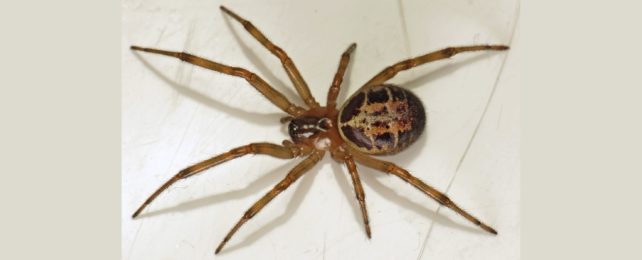Most spiders pose very little danger to humans, including the notorious noble false widow (Steatoda nobilis).
But the half-inch predator does punch surprisingly far above its weight. According to a new study, for example, the noble false widow spider may habitually prey upon vertebrates, with known victims including lizards, bats, and now shrews.
In fact, the study's authors recorded the latter at a gruesome scene outside a bedroom window in southern England, where a female noble false widow spider subdued and consumed a pygmy shrew (Sorex minutus).
Despite its name, the pygmy shrew is a giant compared with the spider, typically measuring about 5 centimeters (2 inches) in length plus a 4-centimeter-long tail.
It's more than triple the length of the 1.4-centimeter noble false widow spider, not counting its tail, and weighs roughly 10 times as much.
While vertebrates are often on the menu for bigger spiders – including members of the tarantula family – they present a different challenge for small spiders such as the noble false widow, which can't wrangle reptiles or mammals as a tarantula might.
So, like true widow spiders (including the infamous black widow and redback spiders), the related noble false widow tackles outsized prey with a combination of potent venom and strong silk.
That's what happened at a home in the city of Chichester, in southern England, where University of Galway zoologist Dawn Sturgess recorded the incredible video below:

The video shows a noble false widow's web, located outside a bedroom window of the house in Chichester, with a small mammal ensnared in the silk. Later analysis of the mammal's remains helped researchers identify it as a pygmy shrew.
The shrew was still alive in the web, the researchers report, although it was only seen making a few slight movements near the beginning of its ordeal. That's probably due to the spider's powerful neurotoxic venom, which is known to cause rapid neuromuscular paralysis.
The spider was seen moving back and forth between the shrew and the rafters above the window, using silk to hoist the shrew upward about 25 centimeters, the researchers report.
After 20 minutes, the spider had lifted its prey into the rafters, partially out of view. It wrapped the shrew in silk, fed on it for three days, and then dropped what was left out of its web.
According to the researchers, "the remains of the shrew were nothing but fur, bones, and skin."
It's unclear how the spider first caught the shrew, but there's a good chance it was no accident.
This is the third report in five years of a noble false widow catching a vertebrate, and their methods point to adaptations for "habitual vertebrate predation," the researchers write.
"This observation demonstrates further that the noble false widow is perfectly adapted to take down large prey, combining potent venom, extremely strong silk, and complex hunting behavior," says lead author Michel Dugon, a zoologist at the University of Galway.
The shrew likely climbed a wisteria bush near the bedroom window, the researchers write, where the spider trapped it with silk, paralyzed it with venom, and then hoisted it to the rafters.
This is the first time any member of the spider family Theridiidae has been recorded preying on a shrew in Ireland or in Britain, the study's authors note.
It's also the first time any species of false widow spider has been reported preying on a shrew anywhere on Earth.
The noble false widow is native to Madeira and the Canary Islands but has become an invasive species in several other parts of the world over the past century, perhaps most famously in the U.K., where misleading tabloid coverage has falsely cast the spider as a deadly menace.
While the noble false widow can deliver a painful bite and may inject pathogenic bacteria along with its neurotoxic venom, it is neither aggressive nor deadly to humans and poses a lower risk to public health than some news articles suggest.
That said, it's an invasive species that could potentially cause problems for people and wildlife, so it's smart to shed more light on this amazing arachnid.
"The noble false widow is a very intriguing spider, and we have much to learn about it still," says senior author John Dunbar, a zoologist at the University of Galway.
"We are very grateful to the members of the public who share their observations with us," he adds. "This allows us to understand better how this invasive species may impact us and our environment."
The study was published in Ecosphere.
